Alignment charts and other low-dimensional visualizations
« previous post | next post »
The current xkcd:
There's a long history of similar diagrams in language-related areas.
A century and a half ago, C.S. Peirce was fond of triangles, like this one:
And this one:
About a century ago, we get the "semantic triangle", from Charles Ogden and Ivor A. Richards, The Meaning of Meaning, 1923:
But those diagrams are not really in direct line to modern "alignment charts", since they represent a graph of pair-wise relations among concepts or processes, rather than points in a low-dimensional vector space whose dimensions have intuitive meaning.
For a more appropriate proximate history, we can start with the idea of "semantic differential" spaces, based on the ideas in Charles Osgood, "The Nature and Measurement of Meaning", 1952. Here's a three-dimensional example:
And another one:
A similar set of ideas lie behind Valence-Arousal theories of emotion:
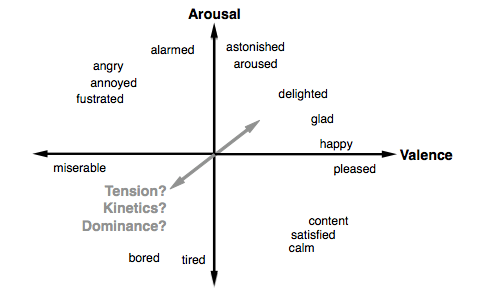
Joe Kruskal's non-metric Multi-Dimensional Scaling (and similar dimensionality-reduction techniques) were in large part an attempt to extend Osgood's ideas about using factor analysis to learn semantic-differential dimensions from observational data of various kinds.
Doug Biber used factor analysis to induce a set of dimensions for register/style/genre:
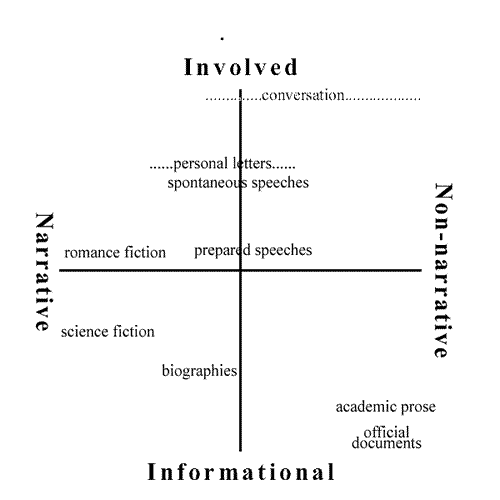
"Latent Semantic Analysis", originally developed by Tom Landauer, Sue Dumais and others in the late 1980s, has a similar historical relationship to Osgood's Semantic Differential ideas, and similarly learns to place words in a multi-dimensional space based on Singular Value Decomposition of a term-by-document matrix. For some pictures, see Landauer et al., "From paragraph to graph: Latent semantic analysis for information visualization", PNAS 2004. A relevant quote:
[W]e conjecture that verbal meaning is irreducibly high dimensional. Thus, the value of automatic reductions to two or three best dimensions may be inherently limited; although they may be valuable for some purposes, they must often provide only an impoverished and possibly misleading impression of the relations in a dataset. Different researchers and scholars are often interested in different aspects of articles, only some of which may have been indexed, key-worded, the object of citation, or shown in a particular view. The alternative we have explored here is a combination of measuring similarity of the entire content of articles with high dimensional visualizations that support search for projections that are of special interest to the user. […]
Despite decades of highly creative and sophisticated innovation, and a plethora of claims for obvious superiority of the visualization approach, we do not see visual maps of verbal information in popular and effective use. It is, of course, possible that visualizing verbal information is in large part just an appealing bad idea. A more optimistic view is that the application of more user testing to understand what does and doesn't help people do what, will steer innovations in more effective directions.
Of course, "alignment charts" (and "vowel charts" and "soil charts" and so on) represent theories about the low-dimensional representations that explain variation in some domain of interest, rather than methods for visualizing the relations among very large sets of arbitrary entities like documents or words.
More recent "word embedding" methods are variations on the same theme as Latent Semantic Analysis — sharing its commitment to residual dimensionality on the order of several hundred rather than two or three. Like LSA, they also descend from Osgood and other mid-20th-century psychologists, a relationship that deserves to be better known than it is.

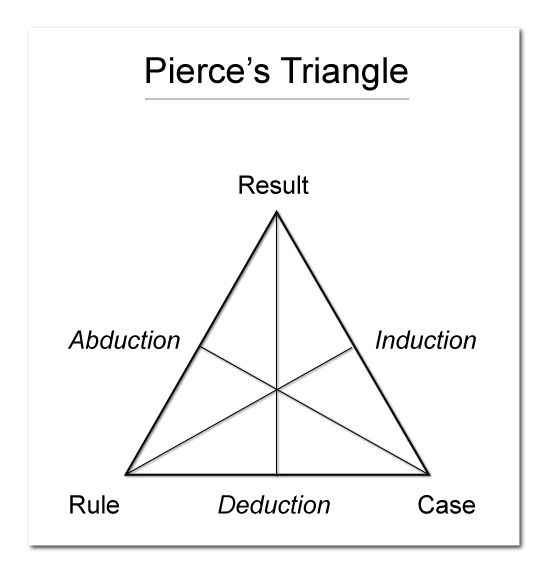


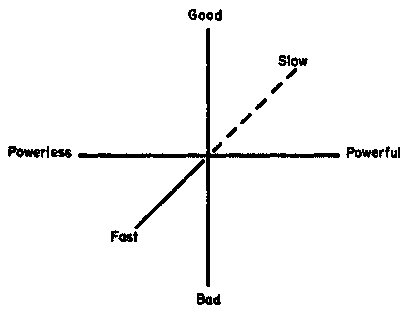

Yuval said,
January 7, 2020 @ 7:14 pm
Does the Vauquois Triangle count?
[(myl) Sure —
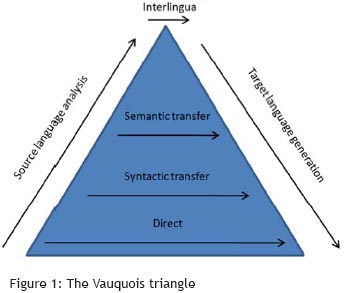
But again, this is more of a graph of relations among concepts or processes, rather than points in a low-dimensional vector space whose dimensions have intuitive meaning.]
D.O. said,
January 7, 2020 @ 9:51 pm
What?
No periodic table?
Lame!
[(myl) Take it up with Randall — though I suppose that the periodic table counts as "language related", in the sense that if there were no atoms, there would probably be no languages.]
John Shutt said,
January 8, 2020 @ 8:13 am
There's the Gnoli triangle, in conlanging (showing the mix of practical, technical, and artistic motives for a conlang).
Andrew Usher said,
January 9, 2020 @ 8:53 am
I can only imagine the humor in this is not being able to find any, though it looks like there should be some. Could someone enlighten me as to the point being made here?
k_over_hbarc at yahoo.com
[(myl) I can't answer for Randall Munroe's point, though I think the idea was just the juxtaposition of unrelated but very vaguely analogous charts from a variety of divergent sources, in a meta-alignment-chart presentation. My own point was mainly to give a shout-out to the Osgood semantic differential stuff, which is less well known than it deserves to be, given its large (though mostly indirect) intellectual influence.]
David said,
January 9, 2020 @ 3:44 pm
Alignment charts are explained here:
https://www.themarysue.com/best-alignment-charts/
The xkcd humor is in a recursive alignment chart, an alignment chart of alignment-chart-like charts. Programmers and other nerds find great humor in recursion.
Andrew Usher said,
January 9, 2020 @ 6:26 pm
I know what the alignment chart is! I was just pointing out that I couldn't laugh until I saw there was literally no joke in it.
The thing about the alignment chart is that it divides what is obviously a continuum of possibilities into an easily memorable finite list of choices. Three of the seven proper subdiagrams are not of that nature: the Punnett square, the phase diagram, and the chromaticity diagram. The first two have only a finite number of possibilities, while the third makes no attempt at division. I assume he could have found three more that were to replace those (any suggestions?).
John Shutt said,
January 9, 2020 @ 6:36 pm
@Andrew Usher: For those of us who struggle to understand some of the subtler or more esoteric aspects of xkcd's, there is an "Explain xkcd" wiki devoted to helping out. I often consult them to see what they have to say, even for the ones I figure I understand. Their motto is "It's 'cause your dumb." In this case:
https://explainxkcd.com/2251/
Andrew Usher said,
January 9, 2020 @ 7:33 pm
Fine, believe that I'm dumb if you want. That page contained nothing I didn't already know. Also, I don't accept the explanation that certain charts are listed under 'chaotic' because they are 'physically' chaotic: the IPA vowel chart is a model of order, indeed too orderly for real language; while the 'political compass' as illustrated is quite chaotic.
John Shutt said,
January 9, 2020 @ 7:53 pm
Actually I figured it was because /I'm/ dumb. But whatever.
Jerry Friedman said,
January 10, 2020 @ 9:21 am
Shouldn't the alignment chart be Lawful? I'm thinking Lawful Neutral.
Thomas Shaw said,
January 10, 2020 @ 12:10 pm
Also, a large part of the appeal of alignment charts is the arguments that follow. I know I'm enjoying this one. For example, I disagree with Andrew Usher about the phase diagram and chromaticity. The first maps continuous Temperature/Pressure to discontinuous thermodynamic states, so it's a bit borderline, but the chromaticity diagram clearly attempts to divide the continuum among common color names.
Andrew Usher said,
January 10, 2020 @ 6:06 pm
I've never seen a chromaticity diagram that attempts to make clear divisions between the colors and his doesn't either (note the absence of such lines). It maps a continuum to a continuum; the use of color names is merely suggestive.
And as for the phase diagram, the mapping of continuous T/P to discontinuous states is set by physical law, not our rules. I see no disagreement there – also, I don't have any desire for argument for its own sake, so see no appeal in that sense for 'alignment charts' such as this.